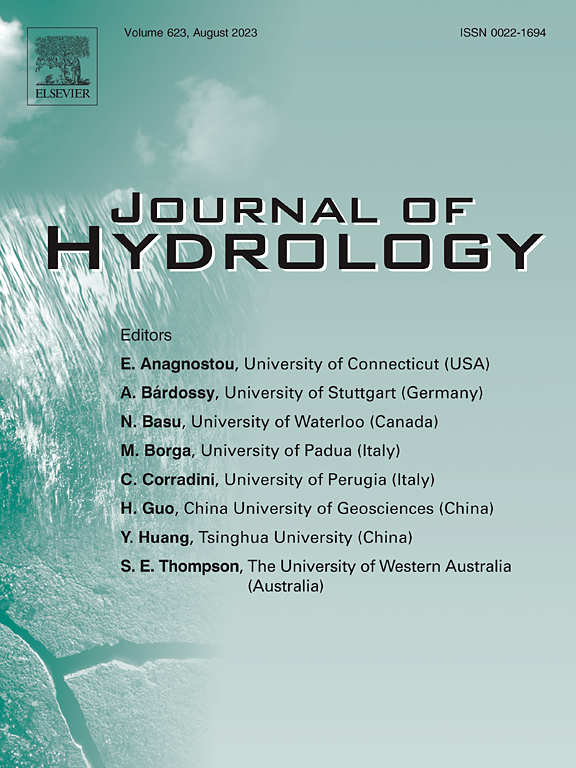Coupled hydrologic, hydraulic, and surface water quality models for pollution management in urban–rural areas
IF 6.3
1区 地球科学
Q1 ENGINEERING, CIVIL
引用次数: 0
Abstract
Urban expansion and increasing frequency of extreme events threaten both urban drainage and receiving waterbody water quality. Combined sewer systems are particularly vulnerable, as they mix wastewater and stormwater, making them susceptible to reduced drainage efficiency and potential release of pollutants. Nature-based solutions, such as constructed wetlands, offer an effective means of pollution mitigation by providing sustainable and cost-efficient methods for enhancing water quality and reducing pollution in urban environments. This study presents a numerical modelling framework to simulate the impact of pollution and to design effective remediation strategies in mixed urban–rural networks subjected to storm events. The model consists of three main modules integrating hydrological, hydrodynamic, and reactive transport components to simulate the water and pollutants dynamics. The first module simulates runoff based on a distributed hydrological model and propagation within the canal network. A reactive transport module simulates advective–dispersive transport and biochemical reactions of pollutants. A third module evaluates the effectiveness of horizontal flow constructed wetlands for pollution mitigation. The model is applied to a suburban area near Milan, Italy, where sewer overflows enter a network of irrigation canals. The results demonstrate that the model was effective in identifying a suitable location for implementing a constructed wetland and in determining its proper size to achieve improved water quality. According to the simulations, the designed treatment system can achieve a contamination reduction of up to 23% for ammonium, 84% for nitrates, and 85% for carbonaceous BOD.
城乡污染管理的水文、水力和地表水质量耦合模型
城市扩张和极端事件频发对城市排水和接收水体水质构成威胁。联合下水道系统尤其脆弱,因为它们将废水和雨水混合在一起,容易降低排水效率,并可能释放污染物。基于自然的解决办法,如人工湿地,通过提供可持续和具有成本效益的方法来提高水质和减少城市环境中的污染,是减轻污染的有效手段。本研究提出了一个数值模拟框架,以模拟污染的影响,并设计有效的补救策略,在混合城乡网络遭受风暴事件。该模型由水文、水动力和反应输运三个主要模块组成,模拟水体和污染物的动态。第一个模块基于分布式水文模型和运河网络内的传播模拟径流。反应性输运模块模拟污染物的平动-分散输运和生化反应。第三个模块评估水平流人工湿地对减轻污染的有效性。该模型被应用于意大利米兰附近的郊区,那里的污水溢出进入灌溉渠网络。结果表明,该模型在确定建设人工湿地的合适地点和确定其适当规模以改善水质方面是有效的。根据模拟,设计的处理系统可以实现高达23%的铵污染减少,84%的硝酸盐,85%的碳质BOD。
本文章由计算机程序翻译,如有差异,请以英文原文为准。
求助全文
约1分钟内获得全文
求助全文
来源期刊

Journal of Hydrology
地学-地球科学综合
CiteScore
11.00
自引率
12.50%
发文量
1309
审稿时长
7.5 months
期刊介绍:
The Journal of Hydrology publishes original research papers and comprehensive reviews in all the subfields of the hydrological sciences including water based management and policy issues that impact on economics and society. These comprise, but are not limited to the physical, chemical, biogeochemical, stochastic and systems aspects of surface and groundwater hydrology, hydrometeorology and hydrogeology. Relevant topics incorporating the insights and methodologies of disciplines such as climatology, water resource systems, hydraulics, agrohydrology, geomorphology, soil science, instrumentation and remote sensing, civil and environmental engineering are included. Social science perspectives on hydrological problems such as resource and ecological economics, environmental sociology, psychology and behavioural science, management and policy analysis are also invited. Multi-and interdisciplinary analyses of hydrological problems are within scope. The science published in the Journal of Hydrology is relevant to catchment scales rather than exclusively to a local scale or site.
 求助内容:
求助内容: 应助结果提醒方式:
应助结果提醒方式:


